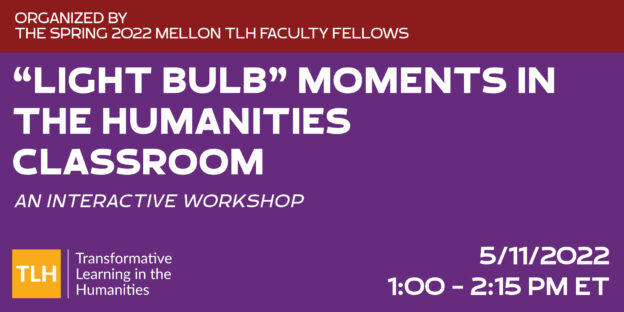On 11 May 2022, Emily Ripley (Queens College), Abby Anderton (Baruch College), Nerve V. Macaspac (College of Staten Island/Graduate Center), Oriana Mejías Martínez (LaGuardia Community College), and Lisa Marie Anderson (Hunter College) shared their experiences of transformative moments in their classroom. They presented examples of active learning from their courses, sharing the work of their students and engaging recentering student voices inside/within the classroom.
IMAGE ABOVE: Students exploring material culture objects from the Queens College Fashion and Textiles Collection in their History of Fashion course. IMAGE SOURCE: Emily Ripley.
With the words and concepts of Audre Lorde and Felcia Rose Chavez in hand, Ripley began the process of reimagining the traditional history of fashion lecture course. The goals were to work towards creating a fully active learning environment, to disrupt the Eurocentric focus of the History of Fashion in the West, and to allow the class to take part in an upgrading project. Across the semester she cracked open the professor/student barrier by establishing an open dialogue with her class, interspersed with regular group think-pair-share moments to involve everyone. A method of investigating material culture objects was refined within the classroom. Students also gained agency by writing questions for the test, and many experienced a new, revelatory understanding of their own learning processes. The professor learned firsthand what particular testing methods were most accessible for her students with learning disabilities, and through discussions with her class, developed a new way to flip the structure of this traditionally formatted course.
IMAGE ABOVE: One student project focused on Florence Price, a Black female composer whose work is receiving renewed interest in concert programs across the US. By exploring her work for String Quartet, the student analyzed Prices’ unique musical idiom and some contemporary performances of her work. IMAGE SOURCE: Abby Anderton
Anderton discussed various digital story-telling tools, including ReadyMag and StoryMaps as a way of making less well-known historical figures audible. She shared her students’ work on composers like Florence Price, Clara Schumann, Alma Mahler, and Charles Ives. Digital story-telling platforms empower students to tell the narratives that are important to them.
IMAGE ABOVE: Students of Urban Geography at CSI used mapping, photo typology, and virtual reality (VR) during field work at the North Shore of Staten Island in examining the differential politics of memorialization, public space and gentrification, and rules of place in New York City’s “Forgotten Borough.” IMAGE SOURCE: Nerve Macaspac
Macaspac presented student-centered projects that activate the students’ sense of place through mapping and spatial ethnography of parts of New York City using a combination of analog (i.e., hand-drawn maps, mixed media, etc.) and digital technology (i.e., virtual reality, video, sound recordings, etc.).
IMAGE ABOVE: Clockwise, the first shows a picture from Madres de Plaza de Mayo; a community and political movement asking for the disappeared-detained people from the Dirty War. Second picture shows a Central American map and pictures of flooded terrain and drought force people from those lands to migrate. Third picture shows an image from La Masacre de Ponce; people are running/escaping. Fourth picture show five images of women from Colombia, three of them on the top; political figures, and two at the bottom; socio political movements made of women against feminicide and supporting abortion rights. IMAGE SOURCE: Oriana Mejías Martínez
Mejías Martínez presented about the opportunities that recentering students’ knowledge in the classroom brings to the class content and experience.
She follows Professor Ofelia García’s scholarship on translanguaging due to broader experiences that these practices foster and develop on language integration and safe space in the classroom. As a result, students were able to choose and work on oral presentations about relatable issues that make historical events even more present at this moment.
IMAGES ABOVE: Top: Some of the artists from Prof. Anderson’s class playlist of music with German lyrics. Below: When reviewing difficult grammar topics, peer instruction led most students to choose the best answer. IMAGE SOURCE: Lisa Marie Anderson.
Lisa Marie Anderson talked about three transformative moments that helped to build community in a first-semester German course. (1) Compiling a course playlist of music with German lyrics introduced students to vocabulary and culture, and also helped them appreciate how much they had learned to understand in just a few weeks. (2) A semester-long virtual study abroad project showed students that they could already use German websites to do things like find a place to live, shop online, and navigate a new campus and a new city. (3) Using metimeter.com and peer instruction to review the midterm exam gave students a low-stakes, anonymous, collaborative way to engage in self-reflection and self-correction.
TLH Faculty Fellows
Emily Ripley (Queens College) is an artist and a fashion historian, director of the Fashion and Textiles Program, and curator of the Queens College Fashion and Textiles Collection. She teaches courses in the history of fashion, fashion and material culture, contemporary dress experiences, fashion and film, and fashion sketching.
Abby Anderton (Baruch College) is a musicologist who teaches topics in music history from Classicism to New Music.
Nerve V. Macaspac (College of Staten Island/Graduate Center) is a political geographer, cartographer, and filmmaker. He teaches courses in Urban Geography and Geographic Information Systems (GIS). His classroom projects can be viewed here: https://geospatialcsi.commons.gc.cuny.edu/
Oriana Mejías Martínez (LaGuardia Community College) is an Adjunct lecturer and teaches Spanish language and culture. Currently a PhD. Candidate at Latin American, Iberian and Latino Cultures program at the Graduate Center.
Lisa Marie Anderson (Hunter College) teaches German language, literature, and culture at all undergraduate levels. She is also a co-founder of ACERT, Hunter’s center for teaching and learning.


